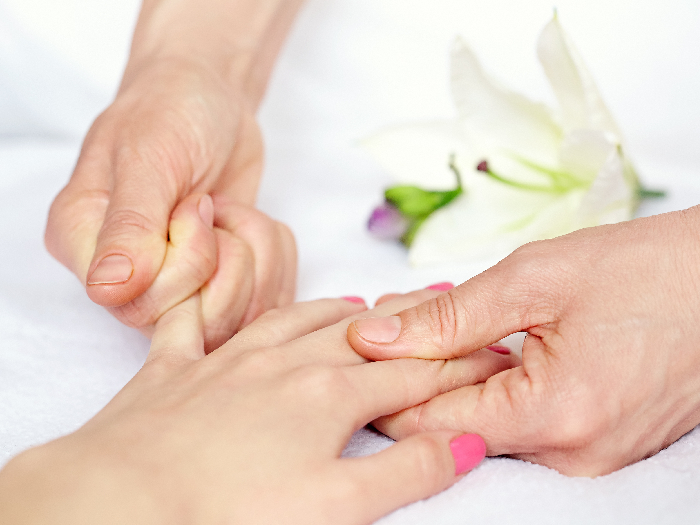Hand reflexology is a massage therapy practice founded on the belief that the entire body is connected through nerves in the hands, in conjunction with the feet and ears.
What is Hand Reflexology?
The manipulation of nerves and pressure points in the hands has been practiced in various forms for more than 4,000 years, dating back to the ancient Egyptians, as per a book called ‘Complementary and Integrative Medicine in Pain Management’. While consistent and peer-reviewed evidence for the efficacy of this therapy is somewhat lacking, there is a huge amount of anecdotal evidence to support these claims. Essentially, hand reflexology—the less popular sister therapy of foot reflexology—consists of applying pressure to certain nerve junctures and pressure points on the hands that are believed to be linked to other parts of the body. Within this belief, applying pressure and stimulating blood flow to those areas can affect change in other areas and organs of the body. [1]
Closely linked to the theories of acupuncture, a staple of Chinese traditional medicine, hand reflexology relies on the same acupressure points in the hands. According to a book, named, Acupressure and Reflexology For Dummies by Synthia Andrews and Bobbi Dempsey, these points may include the lung meridian (a line of points running from the thumb to the wrist), the inner and outer gate points (located on the wrist), the four seams (points on the top knuckles of each finger), the ten dispersions (the tip of each finger), and the Heart 7 (point on the wrist opposite the thumb), among various others. According to hand reflexology practitioners, each of these points is linked to other areas of the body, and pressure applied on said points will affect various health conditions and afflictions, as explained in more detail below. [2]

Hand reflexology can help relieve body aches and pains. Photo Credit: Shutterstock
Benefits of Hand Reflexology
While many of the potential health claims linked to hand reflexology are difficult to replicate and verify, there are some more general benefits of this therapy that are better supported with evidence, including the following.
- Anxiety Levels: According to a study published in Complementary Therapies in Clinical Practice in 2017, hand reflexology showed a positive effect on anxiety levels of patients undergoing coronary angiography. While this is a very narrow finding, it has spurred other research on this therapy’s impact on more generalized anxiety. [3]
- Circulation: A number of studies and anecdotal reports have shown an improvement in circulation as a result of reflexology. The manipulation of pressure points and nerve endings can inherently boost circulation to given areas, so this claim is more widely believed than some others. [4]
- Physical Relaxation: As with any form of massage, hand reflexology does have a relaxing aspect to it, when done properly. This may explain why reflexology and massage have become one of the most popular secondary therapies performed by nurses in clinical settings, since it is also non-invasive, as per a paper published by Dónal P. O’Mathúna, Ph.D. [5]
- Inflammation or Swelling: If you are experiencing swelling or inflammation in the hands or feet, the manipulation of these pressure points is believed to boost circulation and reduce those tight or swollen areas. According to this review, published in the Journal of Traditional and Complementary Medicine, the link between the hands and other parts of the body can aid inflammatory symptoms in non-localized areas as well. [6]
- PMS Symptoms: One of the first mainstream studies related to hand reflexology was conducted back in 1993, and published in Obstetrics and Gynecology. It found that women who underwent hand and foot reflexology experienced notably fewer symptoms of premenstrual syndrome. [7]
- Cancer-Related Symptoms: Researchers have also identified that reflexology can be applied for patients undergoing chemotherapy as a way to increase endurance and energy, reduce nausea and pain, and lower anxiety levels. [8]
- Hand and Wrist Pain: A research review published in the Journal of Holistic Nursing claims that, while research on reflexology in pain management is limited, the overwhelming amount of anecdotal evidence for this effect is hard to deny. Massage and pressure point manipulation on other parts of the body can help to increase circulation and relieve tension/inflammation, which can lead to chronic pain.
Safety
One of the best things about hand reflexology is that there is little to no evidence of any harmful side effects as a result of this therapy. This is a non-invasive therapeutic procedure that can be applied for a huge range of problems as complementary or secondary medicine. The efficacy of the treatment will certainly depend on the practitioner, and there is a chance of discomfort or pain if the reflexologist is inexperienced, but as a whole, this therapy is harmless.
That being said, there are some people who should avoid reflexology, or at least be sure to tell their practitioner about their conditions. If you have recently undergone hand or wrist surgery, or if you suffer from gout, you may not be an ideal candidate for this therapy. Furthermore, for people who have diabetes, arthritis, circulatory issues, or ongoing infections, intense pressure and an increase in blood flow have the chance to exacerbate these problems. Before undergoing a reflexology treatment, be sure to explain your complete medical history to the practitioner to ensure that you are a good candidate. [9]
